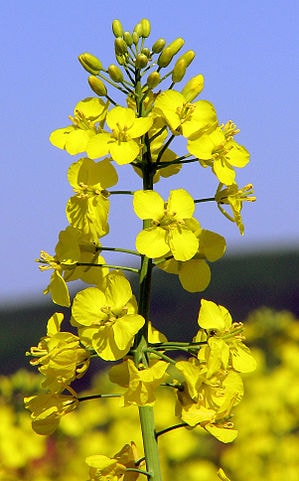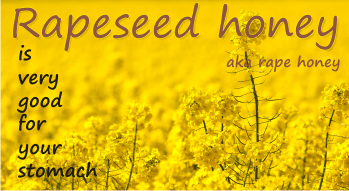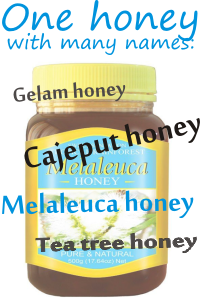If you want to heal ulcer naturally, then try rapeseed honey. It will be perfect for your ulcer diet. Read more to find out if it’s good for you and which are the rapeseed honey benefits for health.
Coming from rape, a plant belonging to BRASSICA SPP., also known as rapeseed, rape is very attractive to bees both for nectar and pollen. In Central and Eastern European rape honey represents one of the most important spring sources, representing a very pure unifloral honey.
The rape is a member of the family Brassicaceae (mustard or cabbage family) and has bright-yellow flowers.
Common name: Rape
I admit. This plant has a horrible name. Rape is a form of human sexual assault. But the plant has nothing to do with this, it is a word that was derived from the Latin for turnip (rāpa or rāpum).
Other names: rapeseed, or even canola (though this refers to canola oil, which is the edible oil produced from the seed of any of several varieties of the rape plant).
Botanical name of plant: Brassica napus 
Place of harvest: Europe, North America,
Sensory description
Colour: white to yellowish, white. After crystallization the honey is whitish or dull ivory.
Aroma: floral – fresh fruit (fruity), warm, spoiled and vegetal
Intensity of odour: medium
Acidity: weak
Sweetness: low. Honeys, like acacia, with high fructose content are sweeter than those with high glucose content.
Bitterness: absent
Fructose content: low
Glucose concentration: high
Mineral content: low
Crystallization: Rape honey crystallizes very fast in a fine-crystalline texture. At higher temperatures (more than 25° C) the crystallization is slowed down. In the deepfreezer honey remains liquid for longer time.
The fast crystallization of rape honey is due to its high glucose content. Generally, honeys with more than 28% glucose crystallize fast, while those with less than 28 % remain generally liquid. Honeydew honeys with more than 10% melezitose crystallize very slowly into the so-called cement honey. (Read more about crystallization of honey)
At the opposite pole there are honeys with low percentage of glucose content, that crystallize in a very long time, if ever. Eg: tupelo honey and chestnut honey.
The good news with this state is that it does not drop off the bread or crackers, due to its paste like texture.
Yeast, fermentation risk: rape (and also sunflower and honeys from tropical countries) has a higher content of osmotolerant yeast and is less stable than other honeys with normal yeast counts.
For a good stable honey, it has to comply to following quality criteria:
· Yeast count maximum 500000 per 10 g
· Glycerol, maximum content: 300 mg/kg
· Ethanol, maximum content 150 mg/kg
The study “Main European unifloral honeys: descriptive sheets” by Livia PERSANO ODDO et al. offers a detailed description of rape honey’s parameters. (See picture)
The study was published by Apidologie 35 (2004) S38–S81 © INRA/DIB-AGIB/ EDP Sciences, 2004.
Antibacterial potency, type of antibacterial activity: low to high. With both peroxide and non peroxide activity (compared to all honeys it is considered of an Intermediate Activity)
GI: 64 (which can be considered medium, if compared to acacia (32), chestnut, linden and heather honey with GI between 49 and 55, and a honeydew honey with the highest GI with 89, which was due to its high melezitose content.)
Compared to acacia honey, which has a low level of glucose and a high level of fructose, rape honey has a high level of glucose, a low level of fructose, and a higher GI than acacia. But the studies say that after eating rape honey, the fructose concentration in blood did not rise as much as (or were the same as) after ingestion acacia honey. Researchers said that fructose metabolism may be inhibited by unidentified substances present in the rapeseed honey¹.
So, if you heard people telling you that a diabetic (can diabetics eat honey?) can eat acacia honey, but no rapeseed honey, these studies say they are wrong.
Imunostimulating effects
Apalbumine 1, the dominant royal jelly in honey with immunostimulating properties, is present in unifloforal honeys in different quantities. The quantity of apalbumine decreases in the following order: Chestnut > Dandelion > Rape, Linden, Acacia². We could say rape honey has a low immunostimulating effect.
Try one of the best German rapeseed honey, available on Amazon.com:
Breitsamer Creamy Honey in Jar, Rapsflower, 8.8 Ounce
Therapeutic applications:
• Sedative, relaxing
• A positive effect of honey on hepatitis A patients was found after ingestion of clover and rape honey, causing a decrease of alanine aminotranferase activity (by 9 to 13 times) and of bilirubin production by 2.1 to 2.6 times.
• Ulcer healing: rape pollen is successfully used to heal ulcers, in folk medicine. Rape honey is the most accepted and the best for the stomach, as it contains few acids (according to Renate Frank). It is even recommended by some pediatric departments in the various universitary clinics, to be used for feeding the newborn children.
• A combination of pollen from Rape, Typhae, Corn, Sunflower have shown in an experimental study that pollen can:
– increasing body tolerance to acute hypoxia and promoting adaptation to highlands (pollen intake can reduce and ameliorate symptoms of acute mountain sickness);
– significantly increase body tolerance to acute hypoxia;
– increase the high energy content and normalize the activity of several enzymes which are important to high energy metabolism;
– regulate the neurotransmitter in 4 parts of the brain and maintain normal activities in the nervous system;
– increase the secretion of adrenocortical hormone which may favour O2 absorption;
– increase SOD content in tissues (heart, liver) and hence may prevent super-oxygenation and guard against free radicals;
– increase PO2 in the brain and arterial blood;
– decrease oxygen consumption and blood lactic acid concentration;
– increase the immunity of animals under
normal condition
In Pakistan, Brassica honey is considered to be great for colon and intestinal health and can be consumed in moderate amounts by type 1 diabetics. Here is some rape honey from Pakistan.

In South Africa, It is highly recommended for kidney diseases and against colesterol. Here is rape honey available in South Africa.
Good for mountain sickness!
Take pollen for 5 days before going to the mountains! It will ameliorate your symptoms of mountain sickness.
The rapeseed oil
Rapeseed is grown for the production of animal feed, vegetable oil for human consumption, and biodiesel. In Europe it is largely cultivated for oil production. It has a distinctive taste and a greenish colour due to the presence of chlorophyll.
The United States Department of Agriculture said that in 2000 rapeseed was the third-leading source of vegetable oil, after soybeanand palm oil.
Canola
Natural rapeseed oil contains 50% erucic acid. Wild seeds also contain high levels of glucosinolates (mustard oil glucosindes), chemical compounds that significantly lowered the nutritional value of rapeseed press cakes for animal feed.
Canola was originally a trademark, but now it is a generic term in North America for edible varieties of rapeseed oil. In North America, the term “canola”, which is a contraction of Can from Canada and ola, from “oil low acid” — came into usage in the 1980s to avoid the linguistic resemblance between the term “rapeseed” and rape (as sexual assault). It became widely used to refer to rapeseed, and is now a trade-name for “double low” (low erucic acid and low glucosinolate) rapeseed.
Rapeseed oil is one of the oldest vegetable oils, but historically was used in limited quantities due to high levels of erucic acid, which is damaging to cardiac muscle of animals, and glucosinolates, which made it less nutritious in animal feed. Rapeseed oil can contain up to 54% erucic acid.
Rapeseed 00 oil, low erucic acid rapeseed oil, LEAR oil, and rapeseed canola-equivalent oil, canola oil are Food-grade canola oil derived from rapeseed cultivars, are generally recognized as safe by the United States Food and Drug Administration.
Canola oil is limited by government regulation to a maximum of 2% erucic acid by weight in the USA and 5% in the EU, with special regulations for infant food. These low levels of erucic acid are not believed to cause harm in human neonates either.
Biodiesel
Rapeseed oil is used as diesel fuel, either as biodiesel, straight in heated fuel systems, or blended with petroleum distillates for powering motor vehicles. Biodiesel may be used in pure form in newer engines without engine damage and is frequently combined with fossil-fuel diesel in ratios varying from 2% to 20% biodiesel.
Due to costs of growing, crushing, and refining rapeseed biodiesel, rapeseed-derived biodiesel from new oil costs more to produce than standard diesel fuel, so diesel fuels are commonly made from the used oil.
Rapeseed oil is the preferred oil stock for biodiesel production in most of Europe, accounting for about 80% of the feedstock, partly because rapeseed produces more oil per unit of land area compared to other oil sources, such as soybeans, but primarily because canola oil has a significantly lower gel point than most other vegetable oils. (according to wikipedia)
=======================
=======================
References:
¹ MÜNSTEDT, K; BÖHME, M; HAUENSCHILD, A; HRGOVIC, I (2011) Consumption of rapeseed honey
leads to higher serum fructose levels compared with analogue glucose/fructose solutions. European
journal of clinical nutrition 65: 77-80.
² BILIKOVA, K; SIMUTH, J (2010) New Criterion for Evaluation of Honey: Quantification of Royal Jelly
Protein Apalbumin 1 in Honey by ELISA. Journal of agricultural and food chemistry 58 (15): 8776-
8781.
http://en.wikipedia.org/wiki/Rapeseed
Rape field picture credit Susanne Nilsson via flickr.com published under CC
“Brassica napus 2” by Tilo Hauke – Self-published work by Tilo Hauke. Licensed under CC BY-SA 3.0 via Wikimedia Commons – http://commons.wikimedia.org/wiki/File:Brassica_napus_2.jpg#/media/File:Brassica_napus_2.jpg






Thank you for this article. It is very informative. We have been taking care of a few hectares of Acacia Forests for many years now thus producing mainly Acacia Honey (https://honeybeeandco.uk/acacia-honey/) and count over 300 families. From next year we will begin taking our bees to a few nearby Rape Flower fields. It’s lovely to learn more about rape honey and its properties.
Kindest Regards
Dragos
Buna Dragos,
Felicitari pentru pasiunea ta si pentru site-ul tau. Incurajez oamenii sa-si faca publicitate aici, pentru ca asa ne facem auziti cu totii. Si cei care ofera si cei care cauta. Deci, thank you for stopping by. 🙂
Laura
Hi, what about the high percentage GMO rapseed plants around? Would it not be a concern if rapeseed honey comes from them?
Hi,
Oh, yes, it is. Not as much because rapeseed is GMO-ed, but because there are so many pesticides used on those crops. Rapeseed honey is not organic and neither is cotton honey. I wrote more about this here: Are there pesticides in honey?
Laura
Thanks for your reply.
Is it true if the bees sense the pesticides they would not gather the pollens?
Well, if the bees sensed the toxicity inside the flower, they wouldn’t gather the nectar or the pollen, of course. But this doesn’t happen, as they die because of this. Yet, somehow, honey bees are able to tell if a person who simply blows in an glass balloon, has cancer or not. See here more info.
Laura
Hi Laura,
Thanks for the great post!:) Rape Honey is one of my favourites, only the raw unprocessed honey has the desired health benefits.
Regards
Tom
http://www.rawartisanhoney.com/
I salute you, honey lover! I always encourage small family business, especially of beekeepers, so I keep your site’s address here and support people to try your honey. From what I understand you are based in the UK, but your honey comes from the US.
When you will grow into a huge business remember to send me an affiliate link. 🙂
Laura
Hi which honey is good for health and specially skin. Borage honey or Rapeseed honey ?
http://localhoneyman.co.uk/products-page-2/local-honey/raw-borage-honey/
Hi Harry,
Skin conditions mean a wide rage of conditions. From ulcers to burns, acne or wrinkles. If you want to externally treat any of these kinds of skin conditions, probably the best honey is manuka honey, or kanuka honey (for acne).
If you were asking which honey is the best for skin, if ingested, I couldn’t name a certain honey, you can choose from lavender, pine, borage honeys, as they are all indicated.
Awesome information here! I love bees, honey, propolis, and bee pollen 🙂
It makes sense that something which is naturally antibiotic can help treat and prevent ulcers (often caused by bacteria).
I’d have never looked for this single sourced honey in particular, so I’m very glad you pointed it out.
Thanks!
Hey, so much info here that’s great! I’m not sure if it’s this plant, but I remember as a kid I would find a certain yellow flower and you could pull the bottom of it off and some sweet liquid came out you could eat. Is it possibly from these plants?
It might have been this one. If it was in spring, with 4 petals, like in the picture, and on wide areas, yes. The liquid must have been the nectar bees gather to make honey. Otherwise the plant is not quite edible for humans. The oil has toxic acids for us. The oil producers take care of them all, but I don’t think we should eat the raw plant.
This was really interesting to learn about, my wife and I are always on the lookout for natural methods of helping the body and I had never heard of rape honey. Thanks for this ! I’ll have to show her this article since I am sure she will love it.
Show her the whole site! 🙂 I’m sure she’ll find something to suit you both.
Thanks for dropping by
Laura
Does it help with allergies? Is there a honey that can help with that? Because I’d LOVE a natural alternative to allergie meds. I haven’t used any, but these are really getting annoying lol.
Hi Alexus,
Yes, it does help with allergy. Please read this article Can honey help with my allergy?
And bee sting allergy can also be treated. Science has evolved a lot in the natural field!
Laura
What an interesting post! I had no idea there was that much difference between different types of honey. Thanks for this information. Regards, Kristina
Oh, there are lots of difference. The type of flower, the season, the weather, the type of bee (they can add different enzymes) they all influence a honey. But the flower is the most important. And how flowers are different, so are honeys made from their nectar.
Laura
Hi Laura, thank you for sharing again. I just like to check, when you say sedative and relaxing, do you mean it will help me with falling asleep? I have troubles falling asleep at night and I hope this can help me.
Gan
It can definitely help. A teaspoon of honey in a glass of warm milk helps a lot. If you don’t like milk, than a tea is just as good. It will help you fall asleep and keep your brain well fed so it will not wake you during your sleep.
Please read honey can treat insomnia.
Laura